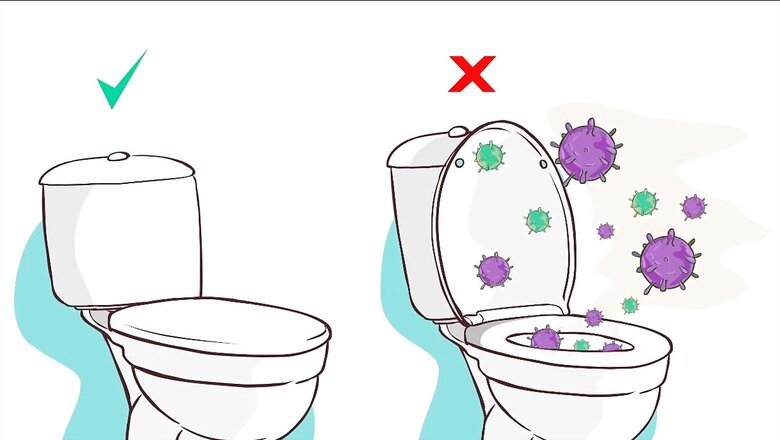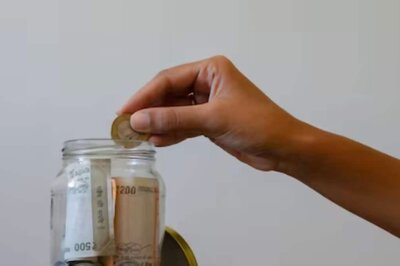
views
While the rest of the world craves longer days and the summer sun, those of us who live in the tropics and sub-tropics crave the rejuvenation and relief the monsoon brings. The rain relieves the scorching heat, and transforms our landscape into a lush, verdant paradise.
On the flip side, the monsoon also brings us a host of challenges and risks, particularly in the realm of public health. This is particularly true in the areas where toilets and sanitation facilities have been poorly constructed and badly maintained. One of the most critical aspects of sanitation is access to safe and clean toilets, which play a pivotal role in preventing the spread of waterborne diseases such as diarrhoea, cholera, typhoid, and hepatitis.
During the monsoon, water sources such as wells, rivers, lakes and ponds are often polluted by runoff from agricultural fields, animal waste, garbage dumps and sewage systems. Damaged and poorly maintained toilets and sanitation facilities contribute faecal waste and wastewater to these water sources, making the pollution far worse, and both increasing the likelihood and hastening the spread of waterborne diseases.
Monsoon floods can also damage water supply infrastructure, such as pipes, pumps and treatment plants, leading to leakage and disruption of safe water access. Moreover, the high humidity and stagnant water create favourable conditions for the growth and multiplication of bacteria, viruses, parasites and fungi that cause waterborne diseases.
Common waterborne diseases during monsoon
Some of the most common waterborne diseases that affect people during the monsoon are:
- Diarrhoea: This is a condition characterised by frequent and watery stools, which can lead to dehydration, electrolyte imbalance and malnutrition. Diarrhoea can be caused by various pathogens, such as E. coli, Salmonella, Shigella, Vibrio cholerae and Rotavirus. Each year, diarrheal diseases caused by poor sanitation and hygiene are responsible for 525,000 deaths of children under five years old, according to the World Health Organization.
- Typhoid: This is a bacterial infection caused by Salmonella typhi, which spreads through contaminated food or water. Typhoid causes high fever, headache, abdominal pain, constipation or diarrhoea, and sometimes a rash. Recovery from typhoid can take months, and necessitates supervision. This is a double whammy for families that live in urban slums – the medical costs aside, this disease also creates enormous loss of income.
- Hepatitis A: This is a viral infection that affects the liver and causes inflammation, jaundice, nausea, vomiting and loss of appetite. Hepatitis A is transmitted through a faecal-oral route, meaning that it can spread through contact with infected faeces or contaminated food or water. The road to recovery is long, and needs hawk like attention to nutrition, which is often challenging in India’s urban slums.
- Malaria: This is a parasitic disease that is transmitted by the bite of infected mosquitoes. Malaria causes fever, chills, headache, muscle pain and anaemia. Malaria can, and often does, have repeat episodes if exposure isn’t limited. Once again, this is very hard to do in India’s urban slums.
Preventing Diseases Through Clean and Safe Toilets
Safe and clean toilets are essential to avoid these health hazards and ensure hygiene and dignity for all. Safe toilets are those that are designed and constructed to prevent human exposure to faeces and to safely dispose of or treat the excreta. Clean toilets are those that are maintained regularly and disinfected to remove dirt, stains, odours, and germs. When these toilets are combined with effective messaging about safe sanitation practices, the benefits are manifold:
- Reduction in Waterborne Diseases: Safe and clean toilets reduce the risk of waterborne diseases by preventing the contamination of water sources and the environment with faecal matter.
- Protection from Infections and Injuries: They protect people from infections and injuries that can occur due to contact with dirty or flooded toilets or open defecation sites. This is particularly true for women and young girls, who are more prone to UTIs and kidney infections.
- Improvement in Quality of Life: They improve the quality of life-being well and of people by providing them with privacy, comfort, convenience, and dignity. Women and young girls, and members of the LGBTQ+ community in particular, can be targeted for physical attacks and sexual violence when they have to ‘find places to go’. In search of privacy, this often leads them to out of the way spaces, where they are much more prone to violence.
- Promotion of Positive Hygiene Behaviours: One of the key observations of the Swachh Bharat Mission is that children who become accustomed to using toilets never go back to ‘the old ways’. A similar shift occurs with other hygiene and sanitation behaviours – like handwashing and toilet maintenance. Toilet signage, education by toilet attendants, and messaging that is echoed through all available media adds up to real behavioural change.
- Contribution to Social and Economic Development: When people aren’t sick as often, aren’t at home as often, taking care of their sick children and sick elders, they contribute to social and economic development by improving productivity, enhancing education, and empowering women and girls.
How Can We Ensure Safe and Clean Toilets
Ensuring safe and clean toilets, especially during monsoon, requires collective action and cooperation from various stakeholders, including governments, communities, civil society organisations, the private sector, media, and individuals. It requires this collective effort, because this is a collective problem.
Our climate is changing. With each degree of rise in global temperature, our monsoons gain 5% more rainfall – an effect we have seen in the increasing instances of floods, cyclones and landslides in the past decade. These incidents aren’t just happening in far flung rural areas. Chennai’s 2015 floods were considered ‘historic’, till they repeated in 2021. Several parts of Kerala are collectively holding their breath, hoping that another deluge doesn’t sweep away their homes, like it did in Wayanad a few years ago. Mumbai grinds to a halt with irritating regularity, several times each monsoon season.
We can’t expect the climate to reverse itself overnight. We have to plan for intense and erratic monsoons. This means, we need to:
- Build Resilient Toilets: Construct toilets that are resilient to floods and storms, by elevating them off the ground level, using materials that are more durable, and construction practices that make them more structurally sound.
- Improve Drainage and Sewerage Systems: to prevent overflow or leakage of wastewater or faecal sludge. This involves certain necessary upgrades like enlarging the drainage pipes, increasing the capacity of storage tanks, constructing additional sewers and drains, and separating stormwater and wastewater.
- Provide Adequate Water Supply: and storage facilities to enable flushing and cleaning of toilets.
- Regular Sanitisation: Use appropriate disinfectants and cleaning agents to sanitise the toilets regularly. Where possible, appoint well-trained toilet attendants who can be trusted to keep the toilets clean, safe and well-maintained.
- Education and Awareness: Undertake awareness and educational programs to spread the word amongst users about the importance of safe and clean toilets and how to use them properly.
- Encouraging Reporting: Encourage people to report any problems or issues with the toilets to the authorities or service providers.
You’ll notice that the last 3 pointers in this list are the true failure points. We can (and have) build great infrastructure and ensure supply of resources, but if the daily cleansing and maintenance doesn’t happen, the toilet quickly becomes a cesspool of disease. In India, where most of us aren’t involved in the cleaning of our own household toilets, it’s no surprise that our public toilets look the way they do.
Toilet Attendants and User Education: Two Levers to Cleaner Toilets
This is why toilet attendants have proven to be the best defence against bad public toilet hygiene. A well trained toilet attendant not only keeps the toilet visibly clean, but also ensures hygiene. They know how to effectively clean toilets, they know what failures to look for and can prevent small plumbing problems from escalating, they can make women and LGBTQ+ users feel safe and welcome, and they can make it easier for people with disabilities to navigate the toilet.
If you’re wondering where one can find toilet attendants of this calibre, Harpic has preempted you. The Harpic World Toilet Colleges began in earnest in 2016, with the stated objective of improving the quality of life of sanitation workers through their rehabilitation by linking them with dignified livelihood options. The college operates as a knowledge sharing platform with an aim to uplift the lives of the sanitation workers by educating them about their rights, health hazards, use of technology and alternate livelihood skills. Workers trained by the college are provided placement with various organisations.
Harpic World Toilet Colleges also confer dignity to the work of sanitation workers – no longer are these looked at as unskilled, lowest of the low workers, but as skilled technicians with specialised training. In this way, Harpic World Toilet Colleges kill two birds with one stone: facilitating clean, safe and well-maintained public toilets across the nation, and generating meaningful and respectful employment for sanitation workers.
Of course, education and awareness of users is paramount. One well-trained and efficient toilet attendant is no match for an army of users who don’t use the toilet correctly. This is where initiatives like Mission Swachhta aur Paani are making significant strides. Mission Swachhta aur Paani, pioneered by Harpic and News18, is a movement that upholds the cause of inclusive sanitation where everyone has access to clean toilets. It advocates equality for all genders, abilities, castes and classes and strongly believes that clean toilets are a shared responsibility. Clean and safe toilets for all means that our communities are healthier, our children spend more days in school and less days out sick, girls don’t drop out of school, our workplaces are more diverse places, and that our cities and towns are cleaner, safer, and more welcoming.
In addition to outreach programs in schools like the Swachhta ki Paathshaala and the recognition of Swacchta Champions, Mission Swacchta aur Paani is creating a strong platform where the right set of stakeholders can come together to discuss issues and take meaningful action. Over the past 3 years, Mission Swachhta aur Paani has hosted several live events, telethons, panel discussions and others that have brought together activists, policymakers, social workers, corporations, celebrities, to make a tangible difference on the way we talk and think about a number of issues, in addition to spurring numerous real world actions.
Mission Swachhta aur Paani is also creating repositories of information that help you have the right conversations. Whether it is educating your children about toilet etiquette, or learning how you can talk to your local municipal ward officer about getting toilet attendants for public toilets in your locality – Mission Swacchta aur Paani has the information you need to make an impactful argument.
Join us here, to learn how you can contribute to this national conversation, and pave the way to a Swasth Bharat, and a Swachh Bharat.



















Comments
0 comment